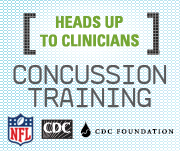Concussion in Sports and Play:
Get the Facts
Children and teens are more likely to get a TBI, including concussion, and take longer to recover than adults. TBI symptoms may appear mild, but the injury can lead to significant life-long impairment affecting an individual’s memory, behavior, learning, and/or emotions. Appropriate diagnosis, management, and education are critical for helping young athletes with a TBI recover quickly and fully.
Did you know?
- Each year, U.S. emergency departments (EDs) treat an estimated 173,285 sports- and recreation-related TBIs, including concussions, among children and adolescents, from birth to 19 years. 1
- During the last decade, ED visits for sports- and recreation-related TBIs, including concussions, among children and adolescents increased by 60%. 1
- Overall, the activities associated with the greatest number of TBI-related ED visits included bicycling, football, playground activities, basketball, and soccer. 1
- National surveillance in 9 high school sports: 2
- TBI represents almost 9% of all injuries reported in the 9 sports
- Numbers and rates are highest in football (55,007; 0.47 per 1000 athlete exposures) and girl’s soccer (29,167; 0.36 per 1000 athlete exposures)
- A national survey of all sports- and recreation-related injuries among all ages demonstrates that 31% occurred in a sports facility and 20% in a school facility. 3
Causes and Risk Groups1
- Children from birth to 9 years commonly sustained injuries during playground activities or while bicycling.
- 71.0% of all sports- and recreation-related TBI emergency department visits were among males.
- 70.5% of sports- and recreation-related TBI emergency department visits were among persons aged 10-19 years.
- For males aged 10-19 years, sports- and recreation-related TBIs occurred most often while playing football or bicycling.
- Females aged 10-19 years sustained sports- and recreation-related TBIs most often while playing soccer or basketball or while bicycling.
Take Action to Address Concussion in Youth and Teens
Over the last 10 years, CDC’s Heads Up initiative has worked to raise awareness about TBI, including concussions. Heads Up tools and resources have helped to improve prevention, recognition, and response to this injury among health care and school professionals, parents, coaches, and children and adolescents.- NEW! Heads Up to Clinicians: Addressing Concussion in Sports among Kids and Teens
- Heads Up to Schools: Know Your Concussion ABCs
- Heads Up: Concussion in Youth Sports
- Heads Up: Concussion in High School Sports
- Heads Up: Brain Injury in Your Practice
Additional Resources
- New Report Traumatic Brain Injuries Related to Sports and Recreation Activities Among Persons Aged ≤19 Years — United States, 2001–2009
- Protect the Ones You Love: Child Injuries are Preventable
- Playground Injuries
References
- Gilchrist J, Thomas KE, Xu L, McGuire LC, Coronado VG. Nonfatal sports and recreation related traumatic brain injuries among children and adolescents treated in emergency departments in the United States, 2001-2009. MMWR 2011: 60(39);1337-1342.
- Gessel LM, Fields SK, Collins CL, Dick RW, Comstock RD. Concussions Among United States High School and Collegiate Athletes. J Athl Train. 2007; 42(4): 495–503.
- Conn JM, Annest JL, Gilchrist J. Sports and recreation related injury episodes in the US population, 1997–99. Inj Prev. 2003; 9:117-123.
Contact Us:
- Centers for Disease Control and Prevention
National Center for Injury Prevention and Control (NCIPC)
4770 Buford Hwy, NE
MS F-63
Atlanta, GA 30341-3717 - 800-CDC-INFO
(800-232-4636)
TTY: (888) 232-6348
New Hours of Operation:
8am-8pm ET/
Monday-Friday
Closed Holidays - cdcinfo@cdc.gov




